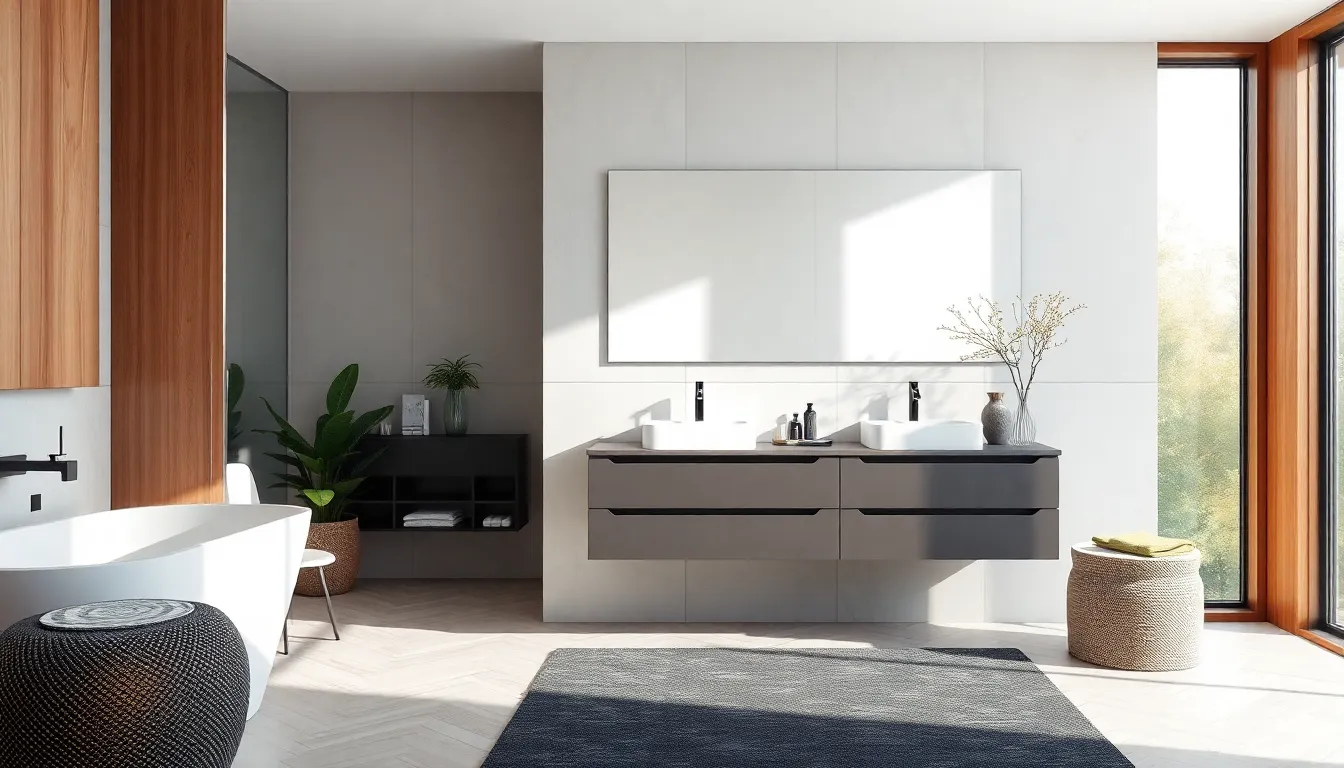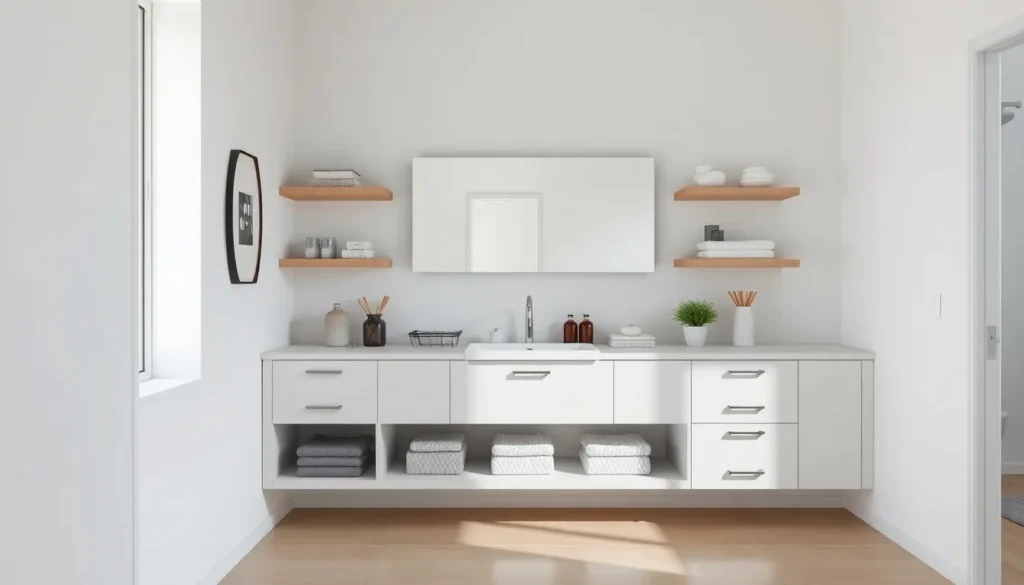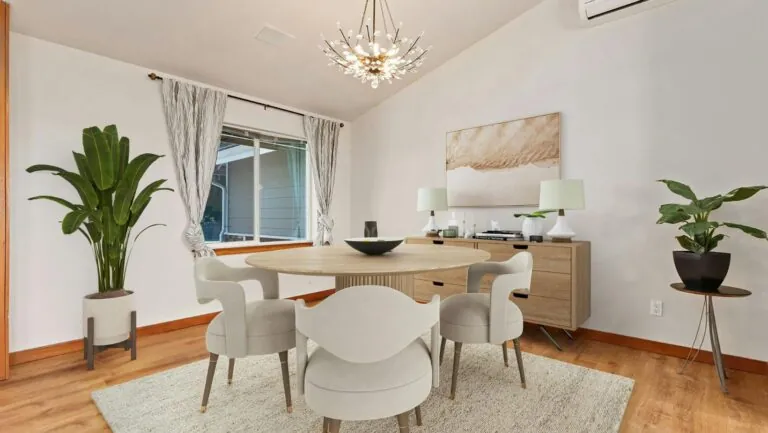A bathroom vanity is more than just a functional piece of furniture; it’s a focal point that can transform an ordinary bathroom into a stylish retreat. With a variety of styles, materials, and designs available, choosing the right vanity can enhance not only the aesthetics but also the overall functionality of the space.
From sleek modern designs to rustic farmhouse styles, the right bathroom vanity reflects personal taste while maximizing storage and organization. Understanding the essential features and trends can help homeowners make informed decisions, turning their bathrooms into a haven of comfort and style. Whether renovating or simply updating, the choice of a bathroom vanity plays a crucial role in creating a space that feels both inviting and practical.
Table of Contents
ToggleOverview of Bathroom Vanities
Bathroom vanities serve as integral components, combining functionality and aesthetics in bathroom design. Their selection impacts both style and storage efficiency.
Definition and Importance
A bathroom vanity is a combination of a sink and storage space, typically including cabinetry. Its importance lies in offering essential organization within the bathroom while enhancing the visual appeal. A well-chosen vanity can streamline daily routines, providing convenient locations for toiletries and linens. It forms the focal point of the bathroom, making it crucial for reflecting personal style.
Types of Bathroom Vanities
Different types of bathroom vanities cater to various aesthetics and space requirements.
- Freestanding Vanities: Adaptable for many bathroom sizes, these vanities rest directly on the floor and allow for easy installation.
- Wall-Mounted Vanities: These units attach to the wall, creating an illusion of more space and making cleaning underneath simpler.
- Double Vanities: Ideal for shared bathrooms, they come with two sinks and extra counter space, accommodating multiple users simultaneously.
- Corner Vanities: Designed to fit snugly into corners, these maximize small bathroom layouts effectively.
- Pedestal Vanities: Featuring a minimalist design, these vanities provide a clean look with a supported basin, suitable for limited spaces.
Choosing a vanity type depends on bathroom size, layout, and personal preferences, ensuring functionality aligns with style.
Choosing the Right Bathroom Vanity

Selecting the right bathroom vanity involves careful consideration of size, space, style, and design. A well-chosen vanity enhances both functionality and aesthetics in a bathroom.
Size and Space Considerations
Assessing dimensions is critical when choosing a bathroom vanity. Measure the available space to ensure a proper fit. Consider vanities that occupy 30 to 72 inches in width, often suited for small to medium bathrooms.
Evaluate the height of the vanity, typically ranging from 30 to 36 inches, which accommodates average user comfort. Keep in mind that clearance space for opening drawers and cabinet doors influences usability. In tight spaces, opt for compact models or wall-mounted units to maximize floor area.
Style and Design Options
Exploring various styles and designs is crucial to finding a suitable bathroom vanity. Popular styles include:
- Modern: Features sleek lines, minimalist designs, and often materials like glass or metal.
- Traditional: Offers ornate details, wood finishes, and classic hardware.
- Rustic: Incorporates natural materials, distressed finishes, and an organic feel.
Select colors that complement existing decor, such as neutrals for a calm atmosphere or bold shades for statement pieces. Organizing storage options, like drawers and shelves, impacts both style and functionality. Prioritize materials that withstand moisture and wear, ensuring durability.
Materials and Construction
Bathroom vanities consist of various materials that influence their appearance, durability, and maintenance requirements. Understanding the common materials used in constructing vanities can aid in making informed decisions that enhance both functionality and aesthetics.
Common Materials Used
- Wood: Popular for its warmth and versatility, wood provides a classic look. Hardwood options like oak and maple resist wear well.
- Plywood: Often used for its stability, plywood offers good durability and is less prone to warping compared to solid wood.
- MDF (Medium-Density Fiberboard): This engineered wood option is cost-effective and resistant to cracking, ideal for painted finishes.
- Laminate: Known for its affordability and wide range of finishes, laminate is easy to clean but may not withstand heavy moisture.
- Metal: Stainless steel and aluminum add a modern touch and resist rust, making them suitable for contemporary designs.
- Glass: Often used for vanities with minimalistic designs, glass provides a sleek look but requires careful handling to avoid breakage.
- Natural Stone: Materials like granite and marble add luxury and sophistication but require sealing to protect against stains.
Durability and Maintenance
Durability depends on the chosen materials. Solid wood and stone offer long-lasting performance but may require more upkeep.
- Wood: Regular sealing and conditioning prevent water damage.
- Plywood: Resistant to moisture when properly finished, it also stands up well over time.
- MDF: Should be sealed adequately, especially around sinks, to prevent swelling.
- Laminate: Easy to maintain but can be easily scratched; using a soft cloth for cleaning is advised.
- Metal: Maintain with a thin layer of protective wax to keep rust at bay.
- Glass: Needs routine cleaning to avoid streaks; use non-abrasive cleaners.
- Natural Stone: Requires regular sealing to enhance water resistance and avoid staining.
Selecting the right materials and understanding their maintenance needs ensures the long-term functionality and aesthetic appeal of a bathroom vanity.
Popular Bathroom Vanity Brands
Several brands dominate the bathroom vanity market, known for quality, design, and reliability. Selecting a reputable brand can enhance both aesthetics and functionality in bathroom spaces.
Brand Comparisons
| Brand | Key Features | Price Range | Notable Styles |
|---|---|---|---|
| Kohler | Innovative designs, durable materials, extensive warranty | $300 – $5,000 | Modern, Traditional |
| Vanity Art | Elegant designs, reasonable prices, large selection | $200 – $2,000 | Contemporary, Rustic |
| Fresca | Sleek styles, customizable options, high-quality sinks | $400 – $3,500 | Minimalist, Transitional |
| James Martin | Craftsmanship, solid wood construction, varied colors | $800 – $4,000 | Classic, Vintage |
| Vinnova | Affordable options, stylish designs, easy maintenance | $300 – $1,500 | Modern, Industrial |
Customer Reviews
Customer reviews play a crucial role in assessing brand reliability and product quality. Feedback often highlights factors such as ease of installation, durability, and overall satisfaction. Popular sentiments include:
- Kohler: Appreciated for long-lasting performance and customer support.
- Vanity Art: Praised for stylish designs and good value for money.
- Fresca: Noted for its modern aesthetics and customization flexibility.
- James Martin: Recognized for exceptional craftsmanship and luxurious feel.
- Vinnova: Valued for affordable pricing and trendy options.
Exterior beauty and interior functionality often dominate customer discussions, guiding potential buyers in making informed choices about their bathroom vanities.
Trends in Bathroom Vanity Design
Trends in bathroom vanity design focus on merging functionality with aesthetic appeal. Current styles highlight innovative features while drawing inspiration from both modern and traditional influences.
Modern vs. Traditional Styles
Modern vanities often feature sleek lines, minimalistic designs, and bold colors. They prioritize functionality with integrated storage solutions, promoting an uncluttered look. Materials such as metal and glass are common, reflecting a contemporary vibe. Examples include wall-mounted vanities, which save floor space while adding a chic touch.
In contrast, traditional styles emphasize ornate details, warmth, and craftsmanship. Elements like wood construction and intricate carvings enhance the rustic feel and showcase classic design. Double sink vanities are popular within this category, accommodating larger bathrooms while adding symmetry and elegance. A standard height for traditional vanities ranges from 30 to 36 inches, promoting comfort and usability.
Innovative Features
Innovative features in bathroom vanities enhance user convenience and efficiency. Some popular functionalities include built-in lighting, which illuminates the sink area for improved visibility. Adjustable shelving provides flexibility, allowing users to customize storage according to their needs.
Smart technology integration offers options such as touchless faucets and heated mirrors, enhancing the overall experience. Additionally, eco-friendly materials and water-saving faucets align with sustainability trends, appealing to environmentally conscious homeowners. Many vanities now come with integrated charging stations, ensuring easy access to power for small devices while keeping surfaces clutter-free.
Overall, the trends in bathroom vanity design reflect a blend of style and utility, catering to diverse preferences and evolving consumer demands.
A well-chosen bathroom vanity can transform a space into a functional yet stylish retreat. By considering size, style, and materials, homeowners can find the perfect balance between practicality and aesthetics. The right vanity not only enhances organization but also reflects personal taste, making the bathroom a more inviting environment. With the variety of options available, from modern to traditional, there’s a perfect fit for every bathroom. Investing time in selecting the right vanity ensures long-lasting satisfaction and elevates the overall design of the home.




